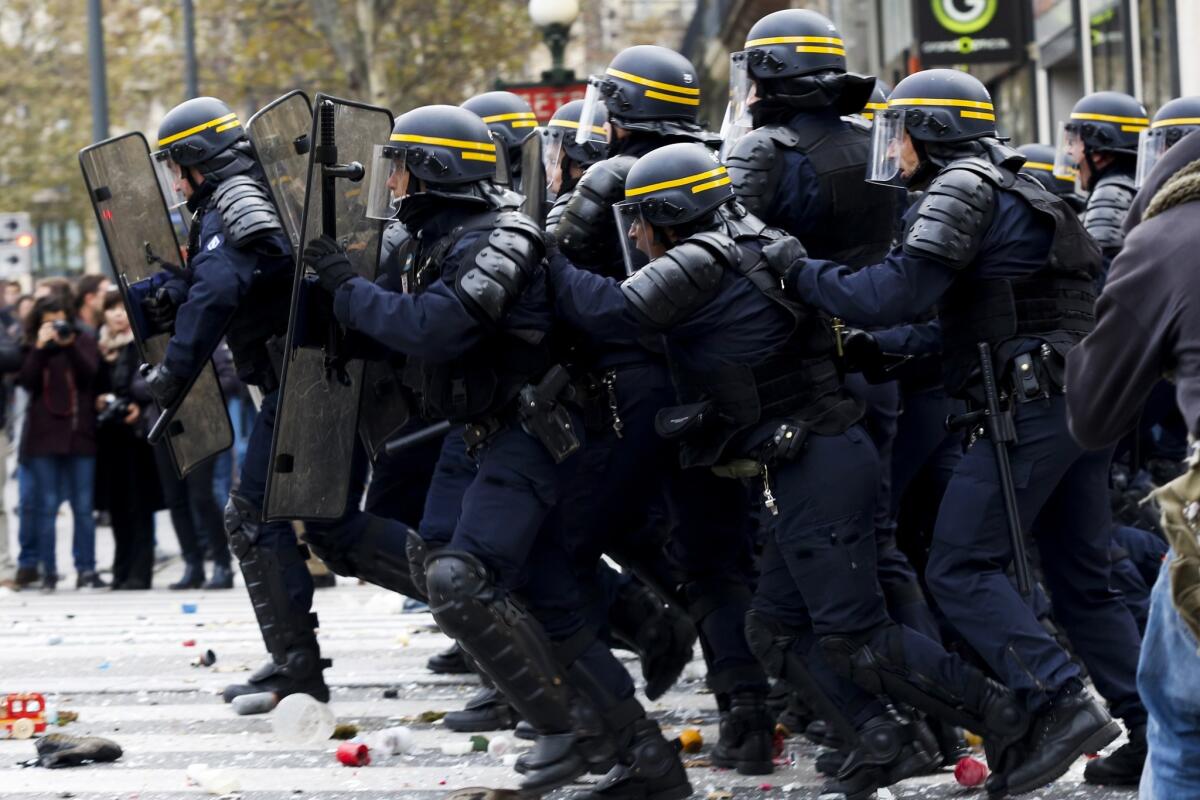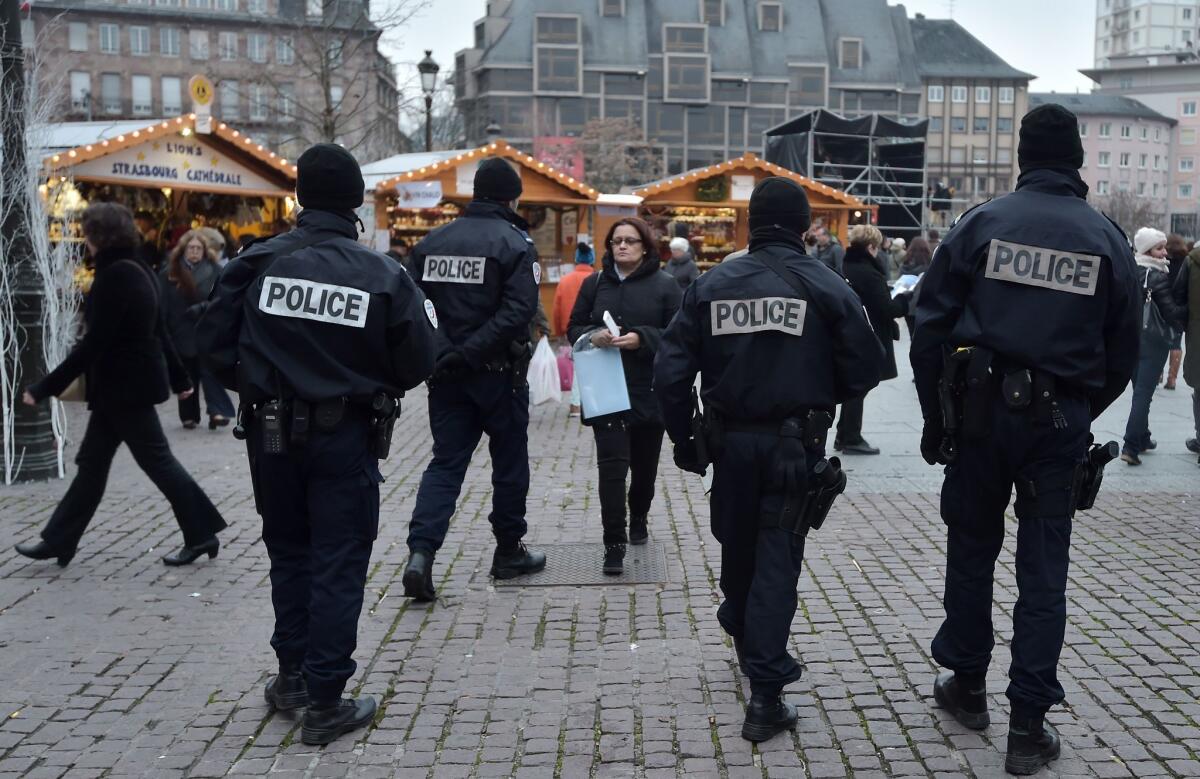A capital under siege: Paris ramps up security for climate talks

Protesters clash with riot police in Paris on Nov. 29 during a rally that demanded action on climate change.
Reporting from Paris â Thousands of armed soldiers and police in the streets. Miles of blocked roads. French authorities have mounted one of the biggest security operations in the nationâs history for the United Nations climate change conference that opens near Paris on Monday.
The event, viewed by many as the most important environmental summit in years, has presented the French government with a major security predicament. Tens of thousands of participants are descending on the capital two weeks after shooting and bombing attacks killed at least 130 people in Paris.
Nearly 150 world leaders, including President Obama, are expected for the opening days of the talks that are scheduled to last two weeks. In addition to the main conference in Le Bourget, on the northern edge of Paris, dozens of side events are planned across the capital.

French police patrol the Christmas market area in the eastern city of Strasbourg on Nov. 27.
With at least two suspects still on the loose, Paris remains a city on edge. Islamic State, the extremist group that claimed responsibility for the Nov. 13 rampage, has threatened more attacks.
But French President Francois Hollande and his ministers were adamant that the conference should go ahead, saying that any delay in talks that have been years in the making would be a surrender to terrorism.
The conference will take place under a state of emergency declared by Hollande in the hours after the attacks and extended by lawmakers for three months.
About 120,000 police, gendarmes and soldiers have fanned out across the country, an unprecedented deployment, officials say.
They include about 2,800 officers assigned to protect the U.N. conference. About 8,000 others are patrolling the countryâs borders after France temporarily suspended its participation in an agreement providing for free movement within the European Union.
In the days since the attacks, Parisians have grown accustomed to having their bags searched at the larger stores and hotels, and seeing armed soldiers patrolling major thoroughfares and tourist sites.
But there was some grumbling on social media when they were asked to leave their cars at home and if possible to avoid using public transport Sunday and Monday. City authorities feared there would be gridlock after miles of roads were closed to allow visiting heads of state and other dignitaries to be ferried quickly and safely between the airports and conference venue.
âDonât use public transport âunless necessaryâ: Can you write me a note for work?â asked one frustrated Twitter user this week.
Stores in Paris were instructed to pull fireworks, household fuels and other flammable materials from their shelves during the conference.
Public demonstrations were banned under the state of emergency, causing friction with environmental groups that were forced to cancel a major march through central Paris on Sunday.
The emergency rules also gave law enforcement officials expanded authority to search buildings and detain people viewed as potential threats to public order, powers they used to place at least 24 activists under house arrest.
Juliet Rousseau, who coordinates a coalition of environmental and social justice groups known as Climat 21, said she understood the need to make changes after the attacks. But she questioned why climate protests were barred when Christmas markets and other large gatherings were allowed to proceed.
âAll this makes us think that the state of emergency is being used as a way to shut us up,â she said.
Activists have vowed to find creative ways to press their demands for an ambitious deal to reduce greenhouse gas emissions and help for poorer countries struggling to cope with climate change.
On Sunday, they lined up thousands of pairs of shoes on Parisâ Place de la Republique to represent the people who could not march. Among the rows of loafers, boots and sandals were a pair of black lace-ups sent by Pope Francis and a pair of running shoes sent by U.N. Secretary-General Ban Ki-moon.
Later, activists chanting, âClimate change is the real state of emergency,â formed a human chain along the intended march route.
Most dispersed peacefully around midday. But a few appeared intent on defying the restrictions, trying to force their way through police cordons, according to officials.
The square, where Parisians have been leaving candles and flowers in memory of those who died Nov. 13, turned into a battleground as police fired tear gas at protesters who hurled shoes, bottles and even candles at them.
Hollande called the violence âscandalousâ and accused protesters of dishonoring the memory of those who died.
More than 200 people, some of whom concealed their faces with masks and balaclavas, were arrested and 174 of them placed into custody, Interior Minister Bernard Cazeneuve told reporters. He blamed the violence on a âsmall minorityâ who were bent on making trouble.
Watching from the sidelines, Benjamin Le Prince was furious.
âLook at all the candles and flowers they are throwing,â said the 30-year-old stylist, who lives in the neighborhood where many victims of this monthâs attacks were gunned down as they sat on cafe terraces and danced at a rock concert. âWe already went through enough violence. We donât need this.â
Others were more sympathetic.
âAll these restrictions of liberty donât only affect Islamist radicals,â said Patrick Creacâh, a 60-year-old teacher who took part in the peaceful protest earlier in the day. âWhen you are 20 years old, you get angry.â
For more international news, follow @alexzavis on Twitter.
More to Read
Sign up for Essential California
The most important California stories and recommendations in your inbox every morning.
You may occasionally receive promotional content from the Los Angeles Times.











